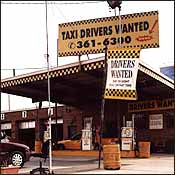
It is a guilty pleasure, i confess, startling the man in the front seat by telling him I once piloted a yellow cab down these mean streets. In the early seventies, taxi driving was considered an acceptable way for a fledgling New York bohemian to earn $175 a week. Now, outside of relentlessly anachronistic Hollywood movies, people who look like me (i.e., white people) do not drive cabs.
Hearing my old-school cab sagas, the present-day internationalist driver is most amazed by the price of a rattling 1974 Checker trip. “Sixty-five cents at the drop, a dime flip every sixth of a mile. Two fifty was a nice ride.” Now, with the May 3 fare increase, it’ll be $2.50 the instant the passenger’s butt touches the seat.
Once upon a time, if a big issue in cab-dom arose, you could check the chatter at the Belmore Cafeteria, a cavernous dispenser of corned beef and other forms of dishealth at 28th Street and Park Avenue. In those Runyonesque precincts, an earlier wave of immigrant driver-raconteurs—Irish, Italian, and Jewish—held forth. They would have eyeballed the fare-rise plan and made perfectly clear how, when all’s said and done, it’s just another way to screw the hardworking taxi man.
Be he from India, Haiti, or Tajikistan, the current driver has inherited his predecessors’ flinty fatalism. “They say it will help pay for gas, but gas is only a few dollars,” says Rachdi Beryoundi, driver of cab No. 4K21. Born in France and brought up in Morocco, Beryoundi expects little from the fare raises: “I lease this cab for $475 for six days. The owners will raise that $25 a day, at least. Then it is $600 to $650. Where is my profit? Sometimes I work all day and make nothing. This stupid taxi is my life.”
This was the general sentiment among cabbies I talked to: Money will be made, but most of it will go into the pockets of the cab owners, who control the (near) priceless medallions and hand out the despised leases. Hussein Mosharoff (medallion No. 8Y79) is so sure the raise won’t help, he is “boycotting thinking” about the May 3 start date. “I don’t want to expect what I’m not going to get,” says the Bangladeshi, a computer-science student at Brooklyn College. Unhappy with the “lack of respect” many New Yorkers extend to “the new-immigrant driver,” Mosharoff is surprised to learn that cabbies once drove without leases.
“Yeah,” I say, “we just showed up at the garage, got the car, and at the end of the shift, the owners took 50 percent of what was booked on the meter.”
A quick study, Mosharoff says, “But if you don’t put on the meter, there is no 50 percent for them to take.”
“Right! You got it!”
At the Ronart cab garage, near Queens Plaza, where men from every continent mill around taxis, the fare hike brings a mixed response. Dominic, a roundish, voluble thirteen-year cab vet from Accra, Ghana, worries about the rise of credit-card use. “Five percent, that’s what they charge for using cards,” says Dominic. “Where will that come from? Not the passenger.” Kamal, a weary-looking university grad from Dhaka, Bangladesh, figures he might make $15 extra a day. Truth be told, he’d rather quit. But “the only skill I have is my knowledge of the streets of New York.”
The Belmore is long gone, but the driver hangout remains, however ethnically fractured. Latin drivers linger at Pollos a la Brasa Mario on 81st Street and Roosevelt Avenue. Egyptian hacks stop on Steinway Street for cardamom coffee and Al-Jazeera on the big screen.
But the real cabbie hangout now is the mosque, places like Madina Masjid at First Avenue and 11th Street. The way they once lined up outside the Belmore, cabs are parked up and down the street, the drivers stopping in at prayer call. Whether the rate hikes are discussed inside those walls is not known.
Related Stories
These 1975 New York Magazine features inspired the TV series Taxi.
The Word from the Belmore
By Mark Jacobson
It’s official: Old-time drivers, who hang out at the Belmore, say they’re suffering.
Night-Shifting For the Hip Fleet
By Mark Jacobson
It has been a year since I drove a cab, but the old garage still looks the same.